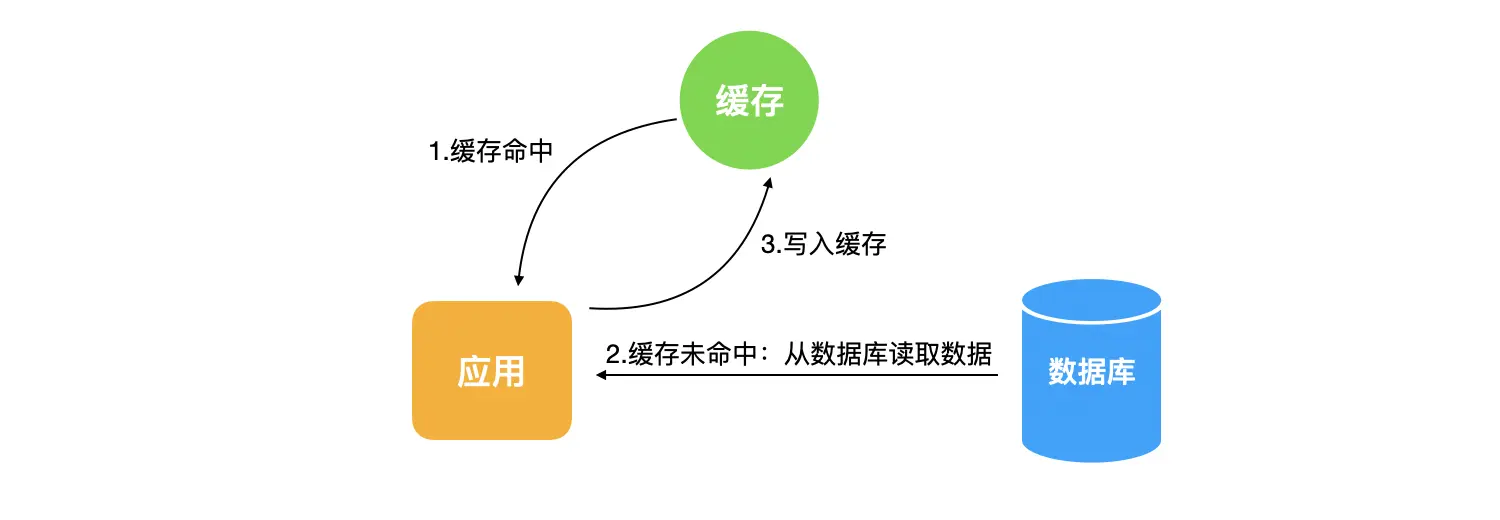cache
什么是缓存
缓存就是数据交换的缓冲区(称作Cache),是存贮数据(使用频繁的数据)的临时地方。有cpu缓存、文件系统缓存、应用层缓存等;今天讲的是应用层缓存:应用层缓存指的是从代码层面上,通过代码逻辑和缓存策略,实现对数据、页面、图片等资源的缓存,可以根据实际情况选择将数据存在文件系统或者内存中,减少数据库查询或者读写瓶颈,提高响应效率。 缓存的本质就是用空间换时间,牺牲数据的实时性,以服务器内存中的数据暂时代替从数据库读取最新的数据,减少数据库IO,减轻服务器压力,减少网络延迟,加快页面打开速度。
以下介绍一些常用缓存的设计模式(结构模式)及数据模式(数据结构)
缓存设计模式
Cache-Aside
 最常用模式。应用程序 先查 缓存,缓存存在 则直接返回;不存在时查数据库,缓存并返回。
缺点:缓存与数据库可能不一致,一般需要设置缓存过期时间
这种一般用于数据变动不太频繁、或者实时性要求不高的场景。
最常用模式。应用程序 先查 缓存,缓存存在 则直接返回;不存在时查数据库,缓存并返回。
缺点:缓存与数据库可能不一致,一般需要设置缓存过期时间
这种一般用于数据变动不太频繁、或者实时性要求不高的场景。
Read-Through Cache
 类似cache-aside,不同的是 缓存是独立的,应用程序不和数据库直接打交道。一般结合下面的write-through一起使用
类似cache-aside,不同的是 缓存是独立的,应用程序不和数据库直接打交道。一般结合下面的write-through一起使用
Write-Through Cache
 数据修改时先将数据写入缓存,缓存再更新到数据库。与read-through结合可解决数据不一致问题;麻烦的是数据变动都要通知缓存变动(如有多个途径修改数据则比较麻烦),还有就是数据变动较多时数据库压力还是不小的,可用于数据表懂较少,但一致性要求高的场景。
数据修改时先将数据写入缓存,缓存再更新到数据库。与read-through结合可解决数据不一致问题;麻烦的是数据变动都要通知缓存变动(如有多个途径修改数据则比较麻烦),还有就是数据变动较多时数据库压力还是不小的,可用于数据表懂较少,但一致性要求高的场景。

Write-Around
 相对于write-through,它是由应用程序将缓存写入数据库;配合cache-aside使用,更新也是由应用程序发起的,但是先写入数据库,再更新缓存(不能如write-through一样先更新缓存,后更新数据库;因为在更新操作来后,如果缓存未写入前其他进程/线程未命中缓存,就会查数据库的旧数据并可能覆盖数据)
相对于write-through,它是由应用程序将缓存写入数据库;配合cache-aside使用,更新也是由应用程序发起的,但是先写入数据库,再更新缓存(不能如write-through一样先更新缓存,后更新数据库;因为在更新操作来后,如果缓存未写入前其他进程/线程未命中缓存,就会查数据库的旧数据并可能覆盖数据)

Write-Back
write-through改良,就是多次更新都是会只更新到缓存,特定时间/特定次数时才会更新到数据库。能够在多修改的场景下降低数据库负担。缺点是缓存崩溃时为持久化数据会丢失

缓存选择
缓存的数据结构
哈希表(散列表)
根据key 获取/设置 value,时间复杂度为O(1)
redis里h开头的命令基本就是对哈希表的操作

集合类(数组/队列)
根据index获取/设置vale,根据index查找时间复杂度为O(1),根据value查找时间复杂度为O(n)
ruby数组是数组与队列的结合,既可以使用index操作,也可以进行push,pop等操作
redis的list为双向链表,查找时间复杂度为o(n)

对可消费资源进行缓存,如消息队列等。特点是一次取一个值(非特定值)
有序集合类(搜索二叉树/跳跃表)
常用的搜索二叉树是红黑树,平衡了搜索二叉树的退化和平衡二叉树的维护开销。
跳跃表就是在链表的基础上增加了多级索引,从而实现查找时间复杂度为O(㏒n)
跳表对比红黑树
 https://github.com/factoidforrest/dynamic-skiplist
redis的有序集合zset采用的就是跳表,zadd时附加score,查找时可按照score进行查找(zrangebyscore)
https://github.com/factoidforrest/dynamic-skiplist
redis的有序集合zset采用的就是跳表,zadd时附加score,查找时可按照score进行查找(zrangebyscore)
他肯定比hash要慢,但提供排序,以及按范围查找数据。业务场景 如 定时任务、排行榜等。 我们的业务我感觉 在 分配类业务时,可根据不同的维度 使用不同的跳表;如分配公司时根据 员工 现有公司数、重点公司数等进行排序后分配,这部分数据可以缓存并在数据变化时更新score;分配时按条件取到符合的 数据的交集,这样就减少了每次分配都要计算的时间消耗。
缓存淘汰策略
先进先出 /FIFO(First Input First Output)
ruby直接hash就可实现,先设置的 shift即移除。 缺点:太过简单粗暴,先缓存的 哪怕后来比其他使用更多,时间更近依然会被淘汰。
####最近最少使用/ LRU(Least Recently Used): LRU算法又叫淘汰算法,根据数据历史访问记录进行淘汰数据,其核心思想是“如果数据最近被访问过,那么将来被访问的几率也更高”。 每次get时把最后访问的放到队尾,每次缓存满时移除队首缓存 缺点:未考虑命中率的问题 https://github.com/SamSaffron/lru_redux
最不经常使用/LFU(Least Frequently Used)
按照访问次数,最近最少使用的缓存数据,先淘汰。有多个最少使用的缓存数据,再按照LRU淘汰。 缺点:命中次数需要记录,计算,多占用内存和cpu。
# Observation
# LFU least frequently used
# key's frequency needs to be tracked
# get(key) -> exist -> freq ++
# -> x -> -1
# put(k, v) -> exist -> modify the node val, freq ++
# -> x -> store and evict (if size is full)
# maintain the HashMap of key the frequency, the value DDL of LRU within that frequency
# 1. frequency map
# 2. node map
# get -> get node -> take that out of frequency map -> put that into the head of now appropriate frequency map list
# put -> (found) get node -> same as get
# -> (new) init node with frequency 1, put that into the map
# -> (if full)
# freq_map[1], remove_from_tail
# {
# 1 => h -> 3 -> 2 -> t
# 2 => h ->
# }
# ["LFUCache","put","put","get","put","get","get","put","get","get","get"]
# [[2], [1,1],[2,2],[1],[3,3],[2],[3],[4,4],[1],[3],[4]]
Node = Struct.new(:key, :val, :usage, :next, :prev)
class DLinkedList
def initialize
@head = Node.new
@tail = Node.new
@head.next = @tail
@tail.prev = @head
end
def empty?
@head.next == @tail
end
def remove(node)
node.prev.next = node.next
node.next.prev = node.prev
node.next = nil
node.prev = nil
node
end
def add_to_top(node)
tmp = @head.next
@head.next = node
node.next = tmp
tmp.prev = node
node.prev = @head
end
def remove_from_tail
raise if empty?
remove(@tail.prev)
end
end
class LFUCache
def initialize(size)
@size = size
@memo = {} # key value map
@freq_map = Hash.new { |h,k| h[k] = DLinkedList.new }
@min_freq = nil
end
def get(key)
return -1 if @size == 0 || @memo[key].nil?
node = @memo[key]
@freq_map[node.usage].remove(node)
# if this has been recorded as min, needs to increment the min_freq lookup counter
@min_freq += 1 if @freq_map[node.usage].empty? && @min_freq == node.usage
node.usage += 1
@freq_map[node.usage].add_to_top(node)
node.val
end
def put(key, value)
return if @size == 0
if node = @memo[key]
node.val = value
get(key)
else
evict if @memo.keys.length == @size
new_node = Node.new(key, value, 1)
@freq_map[1].add_to_top(new_node)
@min_freq = 1
@memo[key] = new_node
end
end
private
def evict
deleted = @freq_map[@min_freq].remove_from_tail
@memo.delete(deleted.key)
end
end
参考:https://cloud.tencent.com/developer/article/2077083